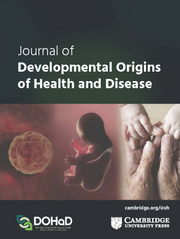Crossref Citations
This article has been cited by the following publications. This list is generated based on data provided by
Crossref.
Sanda, Birgitte
Vistad, Ingvild
Sagedal, Linda Reme
Haakstad, Lene Annette Hagen
Lohne-Seiler, Hilde
Torstveit, Monica Klungland
and
van Wouwe, Jacobus P.
2017.
Effect of a prenatal lifestyle intervention on physical activity level in late pregnancy and the first year postpartum.
PLOS ONE,
Vol. 12,
Issue. 11,
p.
e0188102.
Shepherd, Emily
Gomersall, Judith C
Tieu, Joanna
Han, Shanshan
Crowther, Caroline A
and
Middleton, Philippa
2017.
Combined diet and exercise interventions for preventing gestational diabetes mellitus.
Cochrane Database of Systematic Reviews,
Vol. 2017,
Issue. 11,
Hillesund, Elisabet R.
Bere, Elling
Sagedal, Linda R.
Vistad, Ingvild
Seiler, Hilde L.
Torstveit, Monica K.
and
Øverby, Nina C.
2018.
Pre-pregnancy and early pregnancy dietary behavior in relation to maternal and newborn health in the Norwegian Fit for Delivery study – a post hoc observational analysis.
Food & Nutrition Research,
Vol. 62,
Issue. 0,
Haakstad, Lene A. H.
Vistad, Ingvild
Sagedal, Linda Reme
Lohne-Seiler, Hilde
and
Torstveit, Monica K.
2018.
How does a lifestyle intervention during pregnancy influence perceived barriers to leisure-time physical activity? The Norwegian fit for delivery study, a randomized controlled trial.
BMC Pregnancy and Childbirth,
Vol. 18,
Issue. 1,
Beulen, Yvette H.
Super, Sabina
de Vries, Jeanne H.M.
Koelen, Maria A.
Feskens, Edith J.M.
and
Wagemakers, Annemarie
2020.
Dietary Interventions for Healthy Pregnant Women: A Systematic Review of Tools to Promote a Healthy Antenatal Dietary Intake.
Nutrients,
Vol. 12,
Issue. 7,
p.
1981.
Garnweidner-Holme, Lisa
Henriksen, Lena
Torheim, Liv Elin
and
Lukasse, Mirjam
2020.
Effect of the Pregnant+ Smartphone App on the Dietary Behavior of Women With Gestational Diabetes Mellitus: Secondary Analysis of a Randomized Controlled Trial.
JMIR mHealth and uHealth,
Vol. 8,
Issue. 11,
p.
e18614.
Garcia, Travertine
Duncanson, Kerith
Shrewsbury, Vanessa A.
and
Wolfson, Julia A.
2021.
A Qualitative Study of Motivators, Strategies, Barriers, and Learning Needs Related to Healthy Cooking during Pregnancy.
Nutrients,
Vol. 13,
Issue. 7,
p.
2395.
Taylor, Rachael M
Wolfson, Julia A
Lavelle, Fiona
Dean, Moira
Frawley, Julia
Hutchesson, Melinda J
Collins, Clare E
and
Shrewsbury, Vanessa A
2021.
Impact of preconception, pregnancy, and postpartum culinary nutrition education interventions: a systematic review.
Nutrition Reviews,
Vol. 79,
Issue. 11,
p.
1186.
Hillesund, Elisabet R.
Sagedal, Linda R.
Bere, Elling
and
Øverby, Nina C.
2021.
Family meal participation is associated with dietary intake among 12-month-olds in Southern Norway.
BMC Pediatrics,
Vol. 21,
Issue. 1,
Øverby, Nina Cecilie
Hillesund, Elisabet Rudjord
Helland, Sissel Heidi
Helle, Christine
Wills, Andrew Keith
Lamu, Admassu Nadew
Osorio, Natalie Garzon
Lian, Henrik
Ersfjord, Torunn Iveland
Van Daele, Wim
Bjørkkjær, Tormod
Valen, Erlend Nuland
Gebremariam, Mekdes Kebede
Grasaas, Erik
Kiland, Charlotte
Schwarz, Ulrica von Thiele
Abel, Marianne Hope
Love, Penny
Campbell, Karen
Rutter, Harry
Barker, Mary Elizabeth
Vik, Frøydis Nordgård
and
Medin, Anine Christine
2023.
Evaluating the effectiveness and implementation of evidence-based early-life nutrition interventions in a community setting a hybrid type 1 non-randomized trial – the Nutrition Now project protocol.
Frontiers in Endocrinology,
Vol. 13,
Issue. ,
Osorio, Natalie Garzon
Vik, Frøydis Nordgård
Helle, Christine
Hillesund, Elisabet Rudjord
Øverby, Nina Cecilie
Helland, Sissel H.
Love, Penelope
Barker, Mary Elizabeth
van Daele, Wim
Abel, Marianne Hope
Rutter, Harry
Bjørkkjær, Tormod
Gebremariam, Mekdes Kebede
Lian, Henrik
and
Medin, Anine Christine
2024.
Implementing an early-life nutrition intervention through primary healthcare: staff perspectives.
BMC Health Services Research,
Vol. 24,
Issue. 1,
Medin, Anine Christine
Vik, Frøydis Nordgård
Helle, Christine
Helland, Sissel Heidi
Wills, Andrew Keith
Osorio, Natalie Garzon
Lian, Henrik
Ersfjord, Torunn Iveland
Van Daele, Wim
Bjørkkjær, Tormod
Valen, Erlend Nuland
Gebremariam, Mekdes Kebede
Grasaas, Erik
Kiland, Charlotte
von Thiele Schwarz, Ulrica
Abel, Marianne Hope
Love, Penny
Campbell, Karen
Rutter, Harry
Barker, Mary Elizabeth
Hillesund, Elisabet Rudjord
and
Øverby, Nina Cecilie
2024.
Scaling up evidence-based digital early life nutrition interventions in a county setting: an implementation trial – protocol for Phase 2 of the Nutrition Now project.
Frontiers in Public Health,
Vol. 11,
Issue. ,
Sexton-Dhamu, Meaghan J.
Szymlek-Gay, Ewa A.
Livingstone, Katherine M.
Wen, Li Ming
and
Zheng, Miaobing
2024.
Maternal diet quality trajectories from pregnancy to 3.5 years postpartum and associated maternal factors.
European Journal of Nutrition,
Vol. 63,
Issue. 5,
p.
1961.
Filatava, Evgenia Jen
Overton, Nicolette E.
El Habbal, Noura
Capotosto, Melissa Perez
Gregas, Matt
and
Gregory, Katherine E.
2024.
Women Who Give Birth Preterm Do Not Meet Dietary Guidelines During Pregnancy.
MCN: The American Journal of Maternal/Child Nursing,
Vol. 49,
Issue. 1,
p.
44.
Hillesund, Elisabet Rudjord
Sagedal, Linda Reme
and
Øverby, Nina Cecilie
2024.
Early-life family meal participation and anthropometric measures at 4 years of age.
Journal of Developmental Origins of Health and Disease,
Vol. 15,
Issue. ,
Helle, Christine
Hillesund, Elisabet Rudjord
and
Øverby, Nina Cecilie
2024.
Exploring Public Health Nurses’ Thoughts, Needs and Expectations for the Development and Usability of an Online Parenting Resource on Early Nutrition Delivered through Primary Care: A Qualitative Study.
Nutrients,
Vol. 16,
Issue. 17,
p.
2861.
O’Connor, Hannah
Meloncelli, Nina
Wilkinson, Shelley A.
Scott, Anna Mae
Vincze, Lisa
Rushton, Alita
Dawson, Samantha
Hollis, Jenna
Whiteoak, Bree
Gauci, Sarah
and
de Jersey, Susan
2025.
Effective dietary interventions during pregnancy: a systematic review and meta-analysis of behavior change techniques to promote healthy eating.
BMC Pregnancy and Childbirth,
Vol. 25,
Issue. 1,
Lian, Henrik
Øverby, Nina Cecilie
Vik, Frøydis Nordgård
Medin, Anine Christine
Osorio, Natalie Garzon
Helle, Christine
Bjørkkjær, Tormod
Love, Penelope
Rutter, Harry
Barker, Mary Elizabeth
Hillesund, Elisabet Rudjord
and
Helland, Sissel Heidi
2025.
Implementation strategies: lessons learned during an e-learning intervention to improve dietary behaviors and feeding practices in early childhood education and care.
BMC Nutrition,
Vol. 11,
Issue. 1,


